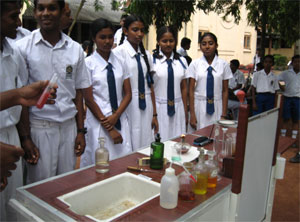Science teachers need high quality equipment and facilities to properly teach the concepts in science. The word laboratory describes a facility that provides controlled conditions in which scientific research, experiments, and measurement may be performed.
In secondary schools here, students have the opportunity to experience science in science laboratories, but at the junior secondary level and in primary schools, science is taught mainly in the classrooms. This project, to design and build a mini science laboratory was done so that both teachers and students could experience teaching and learning science in a more meaningful way.
After all, science is to explore what is happening around us; ask how things happen and why things happen this way; then apply the knowledge to everyday life experiences.
“Necessity is the mother of all inventions”, goes the saying. If one has learn science effectively, it must be experienced. Science is intricately entwined with all aspects of our life today. The science teacher has a definite responsibility to ensure that her/his students learn key concepts in science, but often, lack of laboratory facilities and equipment become the limiting factors and the teacher permits his/her students to resort to passive learning. The good teacher on the other hand with an alert mind, adapts his/her lesson to the materials available.
Science is learning by doing. Teaching and learning mainly depend on hands-on activities. The need for a laboratory is very important. Primary schools have no lab facilities for teaching and learning science. Thus was born an alternative idea – for a mobile science unit and a roving science teacher to take science close to the kids in the class. Curiosity and excitement could be easily built in using this type of mobile unit.
Objectives of the mobile science lab
- Provide a hands-on inquiry based on lab experience with modern classroom equipment and support for implementation of science laboratory curricula.
- Develop and utilize laboratory curricula which address the state’s goal of learning.
- Implement professional development workshop for school science teachers.
What it has
- Fully functional, easy to use and transport, the mobile science lab is complete with storage compartments, sink and white board to write on.
Features
- Science demonstrator table.
- Chemical resistant top.
- Adjustable white board.
- Heavy duty magnetic board to stick poster and chart.
- Plastic sink connects to one litre plastic tank for pumping and draining water (internal water supply).
- External water supply unit.
- Locking supply storage cabinet features a sliding pullout drawer with compartments.
- Rolls on four casters for easy mobility. Solar electricity DC power supply. (Internal electricity power supply) 12 rechargeable battery.
- One outlet electric cord reel with 5amp overload protector(external power supply)
- Sink dimensions
- Foldable attachment to extend the demonstrations table.
- Gas unit
- Safety first aid kit
- Test tube rack to hold test tubes.
In a country like Sri Lanka, improvisation is vital. Wood, metals, adhesives, nails, screws, nuts and bolts, water tap, copper tube, one litre container, one way valves, foot pump, solar electric panel, 12V DC battery, wires, one plug base, one plug top, switch, PVC pipes, jigsaw, drill machines, screw drivers, files, paint brushes, measuring tools, marking tools, moveable joints structures, wood boring tools, waste pipes, hacksaw, handsaw, rasps, additives, plastic disk, rubber tubes etc were used to make the unit.
What procedures were
followed to solve the
problems:-
We encountered many problems as we had to depend on materials from the junk yard. So we had to literally cut the suit according to the length of the material.
During the development, we had to change the working drawing (model and planning) several times. Our initial idea was to get an old trolley and modify it into a mobile unit. When a marketing survey was done on this model, all teachers and working staff liked the model and the idea. Teachers and students gave interesting feedback.
Safety
Proper regard was given for safety and safe working practices. Protective clothing was worn at all times. Care was taken when working with adhesives, to avoid excessive skin contact.
The mobile unit is used to teach scientific concepts. It should be used by teachers only as it is mainly designed for teachers. |


